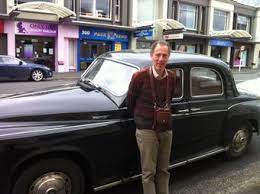Mundolingua is a very special, unique, museum. On show all kinds of objects related to language. Mark Oremland, after having run a travel agency between France and New Zealand (where he was born), decided to found such museum based on those objects that he had been collecting over time. Oremland, who studied linguistics in France, is particularly proud of an early version of the German “Enigma” coding machine and a replica of the Rosetta Stone. It is a two level museum where many computer stations are located, each of them presenting information on a specific area of interest, such as the “Non-Human Language.”
G.G.L
How did you come up with the idea of this unusual museum dedicated to linguistics?
M.O.
I looked for a museum of languages, back in the late 1980s and couldn’t find one, so i said to myself that there was something unique to do! So when i came to Paris in 1994, I enrolled in linguistics at Paris V university and many years later they finally gave me a diploma!
G.G.L.
Where did the name Mundolingua come from ?
M.O.
It is a pure invention, inspired perhaps by latin: Mundo being world and lingua being languages: world of language, languages and linguistics. By chance, the German word for Mouth is Mund and our logo starts with a mouth, but that is pure coincidence
G.G.L.
When did you open the museum ?
M.O.
It was in October 2013
G.G.L.
How is the museum laid out ?
M.O.
There are 2 levels, ground floor and 17thCentury vaulted basement. On the ground floor we have the language section (sounds, meaning, words, grammar, body language and more) which more or less corresponds to general linguistics. At the back, a small continent about learning – one’s own language, foreign languages and problems in the brain.Then down the staircase that we call the Tower of Babel to the basement – continent of languages: origins and myths, families, regional languages, research (with a life sized copy of the Rosetta Stone) disappearing languages (one per month), alphabets, sociolinguistics. This is followed by a section we call “Playing with language”, including invented languages, lies, slang and codes, where we have a real enigma machine from the war. The final small continent at the back is New Technologies and Linguistics as a Science.
G.G.L.
What do you want to teach to the visitors of Mundolingua Museum ?
M.O.
The whole idea is to bring the world of linguistics to the general public, but above all we want visitors to have fun, because there is so much fun stuff in the world of languages. A museum to amuse. Through the interactive screens and games if people learn a few things as well, that is great.
G.G.L.
What are your ambitions for the future ?
M.O.
I think the main thing is to get more people along to the museum – both individuals and groups, be it associations or school outings – there is something for all ages and people from all walks of life.
You can also read: Venezia, Ai Weiwei e la Fondazione Berengo








